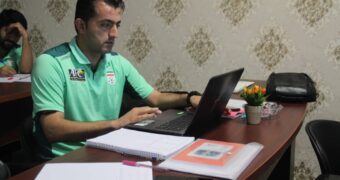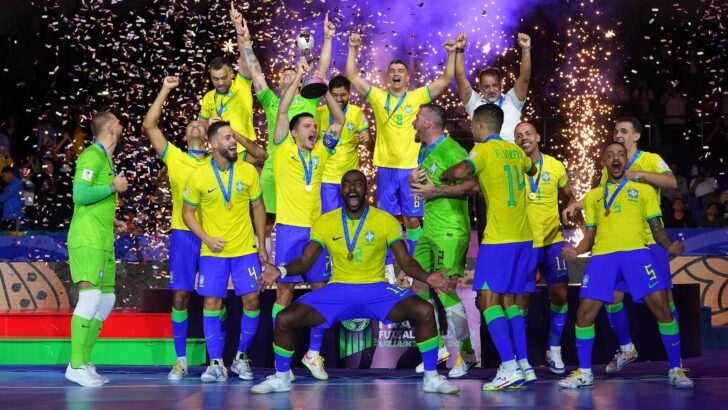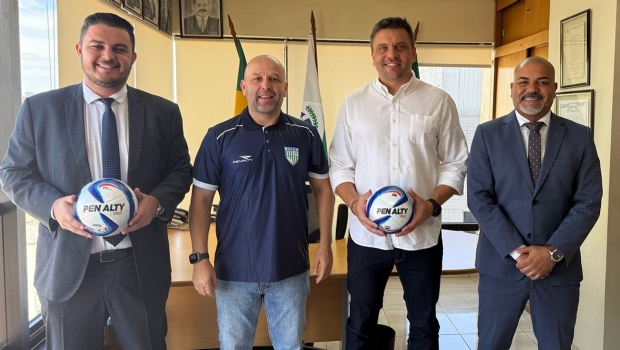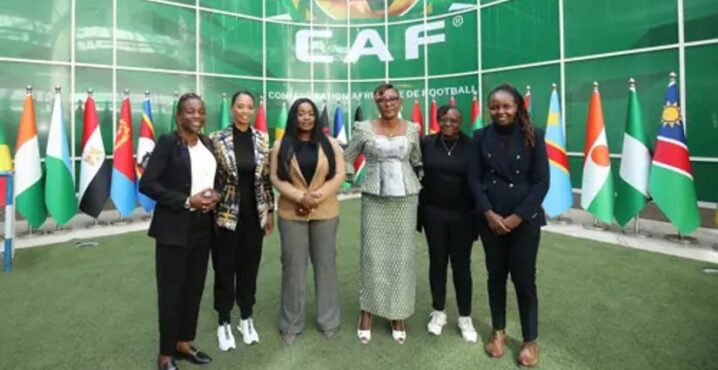Estimated reading time:13 minutes, 5 seconds
Futsal’s Path to Global Recognition: Olympic Dreams, Financial Growth, and the Milestones Ahead
As futsal continues its global journey, the sport stands on the cusp of further growth following the conclusion of the 2024 FIFA Futsal World Cup. This article offers a personal perspective on futsal’s expansion under FIFA’s leadership. While it is important to acknowledge the groundwork laid by FIFUSA (now AMF), founded in 1971, it’s equally crucial to highlight the rapid progress the sport has made since 1989. FIFA has played a key role in developing futsal, establishing the foundation for the professionalisation and global reach we see today.
Source of the main picture: FIFA
By comparing futsal’s current progress to football’s development in the 1950s and 60s and the rise of women’s football in the 1990s, we can better appreciate futsal’s steady trajectory. Through media exposure, marketing efforts, and the growth of domestic and international competitions, futsal is solidifying its place on the world stage—poised to make an even greater impact in the coming decades.
Futsal’s Growth Since 1989: Domestic and International Expansion
Since the inaugural FIFA Futsal World Cup in 1989, futsal has gained momentum globally, fueled by the establishment of key domestic leagues and international competitions. A significant milestone in 1989 was the founding of the Liga Nacional de Fútbol Sala (LNFS) in Spain, providing a structured, competitive environment that helped to establish Spain as a futsal powerhouse. Spain’s LNFS, along with its elite clubs like Inter FS and FC Barcelona drove the nation’s dominance in international futsal though the league no longer controls Spanish futsal which is under the control of the Royal Spanish Football Federation today.
Other countries followed Spain’s lead:
- Brazil: In 1996, Brazil launched the Liga Nacional de Futsal (LNF), further cementing its dominance in the sport.
- Portugal: The Portuguese futsal league was developed in 1990, with clubs like Sporting CP and Benfica becoming leaders in both domestic and European competitions.
- Italy: (Before FIFA) Italy’s Serie A futsal league emerged in 1984, but has become a consistent contender in European competitions.
- Russia: Russia’s Futsal Super League also gained momentum since its launch in 1991, fostering a strong futsal culture and achieving success at the international level.
- Iran: The Iranian Futsal Super League was established in 2003, and Iran has become a dominant force in the AFC Futsal Championships.
- Japan: Launched the F.League in 2007, quickly expanding Japan’s presence in the global futsal scene.
- Thailand: The Futsal Thai League began in 2006 and remains one of Southeast Asia’s strongest leagues, though it largely operates at a semi-professional level.
- Malaysia: The Malaysia Premier Futsal League (MPFL), established in 2019, represents a key step towards professionalizing futsal in the country.
- Indonesia: The Indonesia Pro Futsal League, established in 2006, showcases a competitive scene but remains mostly semi-professional.
These leagues have been instrumental in shaping futsal’s global development. Southeast Asian leagues, though steadily growing, still have work to do to achieve full professional status. Nevertheless, the global expansion of futsal leagues since 1989 highlights how FIFA’s leadership has helped the sport flourish.
International Competitions: Boosting Global Competitiveness
Futsal’s rapid growth also resulted in the launch of several key international competitions that have significantly boosted the sport’s visibility and competitiveness:
- UEFA Futsal Champions League: Originally the UEFA Futsal Cup, launched in 2001, offers Europe’s top futsal clubs a platform to compete internationally.
- AFC Futsal Club Championship: Founded in 2010, this competition provides a stage for Asia’s best futsal teams.
- CONMEBOL Libertadores de Futsal: South America’s premier futsal club competition, strengthening the sport in the region. The current format was launched in 2000. Though the region had a precursor event before CONMEBOL.
- OFC Futsal Champions League: the premier futsal competition for club teams in Oceania, was launched in 2019. Still in its infancy, it is a competition that will continue to grow.
- The Concacaf Futsal Club Championship: Concacaf launched its first edition in 2014 as the regional futsal competition for club teams across North and Central America and the Caribbean. However, the competition faced challenges in terms of continuity and was eventually suspended.
- Africa: The Confederation of African Football has yet to launch a competition due to the sport’s development still at an early stage.
In addition to these competitions, futsal’s inclusion in the Youth Olympics in Argentina in 2018, with its scheduled return in 2026 Senegal, has played a significant role in introducing the sport to a broader youth audience. Building on this, the establishment of youth-specific competitions, such as the U19 Men’s Futsal EURO, launched by UEFA in 2019, further strengthens the sport’s development at the grassroots level in Europe. Similar junior competitions have emerged across regions like Asia (through the AFC U20 Futsal Championship, launched in 2017) and South America.
On the senior side, futsal continues to expand its reach globally through prestigious tournaments like the UEFA Futsal EURO, which has been running since 1996 for men and was expanded in 2019 to include a women’s edition. The Copa América de Futsal in South America, and the AFC Futsal Championship in Asia, provide further competitive platforms for senior national teams for men and women.
In another exciting development, UEFA and CONMEBOL strengthened their collaboration through the Finalissima, an intercontinental competition between the champions of UEFA and CONMEBOL, designed to foster greater interaction between the two confederations. This agreement highlights the increasing level of cooperation and shared vision for growing futsal on a global scale.
Additionally, the upcoming FIFA Women’s Futsal World Cup in 2025 represents a landmark step for the women’s game, complementing the development brought about by the UEFA Women’s Futsal EURO and similar competitions in other regions. These events, combined with youth, senior, and intercontinental competitions, are significantly expanding futsal’s global footprint and elevating the sport across all age groups and genders
Media, Marketing, and Broadcasting: Football, Women’s Football, and Futsal
Football in the 1950s and 1960s: The Birth of Global Broadcasting
Football’s global rise in the 1950s and 60s is closely tied to the expansion of television broadcasting. The 1954 FIFA World Cup in Switzerland was the first to be televised, primarily to European audiences. Although the coverage was limited, this laid the foundation for football’s future commercial success, with sponsorship and broadcasting deals transforming the sport by the 1970s.
Women’s Football: Struggles and Breakthroughs
Media coverage of women’s football remained minimal during the early 1990s, including at the 1991 FIFA Women’s World Cup in China. The 1999 World Cup in the U.S., however, marked a turning point, drawing large audiences and sparking a surge in media interest. It wasn’t until the 2010s, with the rise of fully professional leagues in England, Spain, France, and Germany, that women’s football began receiving consistent media coverage and lucrative sponsorships.
Futsal: Growing but Still Limited Exposure
Despite its steady growth, futsal has yet to fully break through on the global media stage. Since its debut in 1989, futsal broadcasts have largely been regional, concentrated in countries with well-established futsal cultures. However, the 2024 FIFA Futsal World Cup marked a significant step forward, with FIFA broadcasting the tournament for free via FIFA+, thereby expanding the sport’s reach to new nations and regions.
Even with this progress, futsal remains underrepresented on major global networks, limiting its ability to attract substantial sponsorships and broaden its audience. The potential inclusion of futsal in the Senior Olympics could provide a breakthrough, increasing media attention and creating commercial opportunities.
However, futsal faces challenges in gaining media traction in markets where women’s football has thrived, such as the U.S., England, France, Germany, Spain, and Australia. In the U.S., for example, futsal has struggled to gain strong backing from U.S. Soccer, which has primarily focused on traditional football/ soccer. The longstanding presence of the Major Arena Soccer League (MASL) and its predecessors, which have been popular since the 1970s, has created an obstacle to futsal’s growth in the country. Indoor soccer’s fast-paced, high-scoring format appeals to American sports audiences, and its early integration into U.S. soccer culture has created a legacy that has influenced small-sided soccer development. Had indoor soccer not gained such a foothold, futsal might have emerged as the dominant small-sided variant in the U.S., possibly leading to stronger support from U.S. Soccer and deeper integration with the global futsal scene.
In England, the Football Association (FA) has outsourced its futsal operations to a delivery partner, England Futsal, limiting the sport’s integration into its broader football development strategy. While futsal has a strong foothold in certain countries, such as France, where the French Football Federation (FFF) has committed significant funding to futsal’s growth, and Germany, which continues to show increasing support for the sport, other markets like Australia and England have experienced inconsistent investment and structural support.
Nevertheless, digital platforms are emerging as powerful tools for futsal’s global exposure. For example, Magnus Futsal’s documentary series, Vai Pra Cima Fred, attracted over 21 million views on YouTube—just shy of the 23 million viewers who tuned in to watch The Last Dance, the Netflix documentary about the Chicago Bulls. This achievement underscores how futsal can captivate large audiences when delivered through innovative platforms, highlighting its potential to reach broader markets if given the right exposure.
The Women’s Football Parallel: Slow but Steady Growth
The rise of women’s football offers a valuable comparison to futsal’s development. Women’s football began gaining significant global attention in the 1990s, particularly following the inaugural 1991 FIFA Women’s World Cup in China and the landmark 1999 edition in the United States, which was a pivotal moment for the sport’s visibility. However, much like futsal, it took decades for women’s football to establish professional infrastructure, secure sustainable financial backing, and attract widespread media attention.
By the early 2000s, many women’s football leagues remained semi-professional, offering limited opportunities for players. In the United States, the first fully professional women’s league, the Women’s United Soccer Association (WUSA), was launched in 2001 but collapsed after just two seasons due to financial difficulties. Professional women’s football returned to the U.S. in 2009 with the Women’s Professional Soccer (WPS) league, which faced similar struggles before being succeeded by the National Women’s Soccer League (NWSL) in 2013. Despite these early setbacks, the U.S. Women’s National Team played a critical role in supporting the sport, with central contracts helping keep top players in the game.
Europe’s progress was similarly gradual. The Women’s Super League (WSL) in England officially became professional in 2018, although clubs like Manchester City and Chelsea had begun offering full-time contracts earlier, in 2014 and 2015 respectively. France, Spain, Germany, and Sweden followed suit in the 2010s, leading to a marked improvement in the quality of play and a surge in media coverage.
Australia’s W-League, launched in 2008, was an early leader in professionalizing women’s football, and in Asia, China launched its first professional women’s league in 2015, followed by Japan’s WE League in 2021. This steady shift towards professionalism, increased investment, and media attention has helped create the strong global landscape seen today, where top clubs are fully professional and backed by substantial financial resources.
Futsal’s journey from 1989 to 2024 mirrors this trajectory. Like women’s football, futsal has faced challenges, including limited media coverage and semi-professional leagues in many regions. Yet progress is evident, particularly in countries like Brazil, Portugal, and Spain, where professional futsal teams have thrived. The 2024 World Cup showcased the rise of additional nations, most notably France, whose futsal growth has been significant. The French Football Federation (FFF) committed €18 million between 2022 and 2025 to elevate French futsal, improve elite training structures, and expand the sport’s presence across youth and women’s competitions.
This dedication has paid off, as demonstrated by France’s semi-final appearance at the 2024 World Cup. It remains to be seen whether the FFF will extend its financial commitment beyond 2025, but their investment has already aligned with key initiatives, including the country’s bid—albeit unsuccessful—to host the UEFA Futsal EURO 2026. This commitment underscores the federation’s determination to continue developing the sport.
FIFA’s Push for Olympic Inclusion: A Major Milestone
Perhaps the most significant indicator of futsal’s growing relevance is FIFA’s recent confirmation that it will recommend futsal for inclusion in the 2028 Summer Olympics. This could be transformative, as Olympic inclusion would expose futsal to a global audience, unlocking new media, sponsorship, and professionalization opportunities. Women’s football experienced a similar surge in growth following its inclusion in the 1996 Olympics, which significantly elevated the sport’s profile. Futsal could see comparable growth if it follows this path. Though the chances of full inclusion in the 2028 U.S. Olympics remain slim due to U.S. Soccer’s limited focus on futsal, the event could serve as a demonstration sport. However, the 2032 Olympics in Brisbane, Australia presents a more realistic opportunity for futsal, provided Football Australia builds stronger backing for the sport in the coming years. Futsal has been played in Australia for several decades, with its roots dating back to the 1970s and 80s. Queensland, in particular, has been a central hub for the sport, hosting various local and national tournaments.
Conclusion: Futsal Is On the Right Track
When comparing futsal’s progress from 1989 to 2024 with the development of football in the 1950s and women’s football in the 1990s, it’s clear that futsal is progressing at a steady, sustainable pace. With increasing media attention, the establishment of professional leagues, the expansion of international competitions, and FIFA’s push for Olympic inclusion, futsal is well-positioned to reach new heights in the coming decades.
As noted by Laurent Morel, UEFA Futsal Competitions Manager, after the 2024 FIFA Futsal World Cup: “It was crystal clear that the sport has reached a threshold and shall now be generating revenues in line with what it has to offer.” He highlighted the event’s impressive stats, including over 9,000 spectators for key matches, 103 shot attempts in a semifinal, and significant advancements in player skills. Morel further emphasized that futsal has all the ingredients needed for growth and stated, “It’s certainly time for this game to dream big, and for sure bigger.” He pointed toward key upcoming events, including the FIFA Women’s Futsal World Cup in 2025, the sport’s 100th anniversary in 2030, and a potential breakthrough with the 2032 Summer Olympics【source: LinkedIn post by Laurent Morel】.
The steady progress of women’s football over the past 30 years demonstrates that major breakthroughs take time, and futsal’s future looks equally promising. With increased investment, international collaboration, and strategic media exposure, futsal is poised to become a key player on the global sports stage. The old guard can be assured: futsal is on a growth trajectory similar to other sports that have achieved global success.
Related article: 2024 FIFA Futsal World Cup: A Triumph of Development, But Is It Time for Commercialization?
Organ Donation
Futsal Focus is a supporter of Dáithí Mac Gabhann and his family’s campaign to raise awareness of Organ Donation. We encourage our readers to learn more about Organ Donation: https://www.organdonation.nhs.uk/
Futsal Focus
You can read more articles about global futsal by going to the top navigation bar or by clicking here
If you like this article and would like to keep updated on Futsal news, developments, etc then you can now follow Futsal Focus via Google News by following our page which will send you an alert as soon as we publish an article so please click here and follow us on Google.
You can also keep updated on Futsal news, developments, etc then please submit your email below in the Subscribe to Futsal Focus option.
Follow Futsal Focus by clicking on Facebook, Twitter, or Instagram or on the social media buttons on the website
















![Validate my RSS feed [Valid RSS]](https://www.futsalfocus.net/wp-content/uploads/2020/01/valid-rss-rogers.png)




